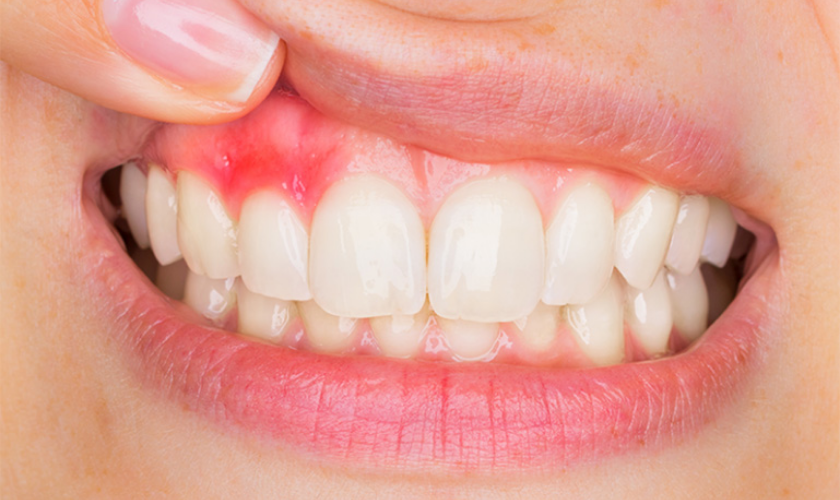
Periodontal disease, or simply gum disease, is one of the most common issues people encounter with their teeth. The good news is that when it’s caught early and treated, you can work your way back to healthy gums. The bad news is that if you ignore periodontal disease, it can become irreversible and lead to more severe health problems or tooth loss.
There are six types of periodontal disease representing the progression of tooth decay. We’ll break down each phase of gum disease, but if you have any reason to believe that you might have periodontal disease, it’s best to schedule an appointment with your dentist ASAP.
1. Gingivitis

Gingivitis is the earliest form of periodontal disease and the only type that can be reversed. Gingivitis is extremely common and is often caused by a lapse in proper oral hygiene.
Many patients with gingivitis have plaque buildup on their gumline, causing their gums to swell. Normally healthy gums are pink and firm, so the first sign of gingivitis is tender, red gums. Those with gingivitis are also prone to bleeding, and their gums may be sore to the touch.
Treating gingivitis is often as easy as staying on top of your oral hygiene routine, complete with twice-a-day brushing and flossing. In some cases, your dentist may recommend a mouthwash to help clean out any lingering plaque and prevent the disease from progressing.
2. Periodontitis

Periodontitis is advanced gum disease. Unfortunately, the damage is irreversible once you cross the line from gingivitis to periodontitis.
Periodontitis sets in when the infection spreads below the gumline and affects the surrounding teeth and jawbone. The disease can lead to bone deterioration, tooth loss, and jawbone atrophy.
Typical signs of periodontitis include receding gums, chronic bad breath, gingival pockets that may contain pus, and the other symptoms associated with gingivitis.
3. Aggressive Periodontitis
Aggressive periodontitis is a type of gum disease that progresses rapidly. In these cases, the decay of the gingival tissue, gingival ligaments that hold your teeth in place, and bone occur faster than they would with other forms of periodontal disease.
Those with aggressive periodontitis may find themselves experiencing tooth loss at an accelerated rate and may need to consider having teeth removed and replaced with implants to mitigate the damage.
Aggressive periodontitis is typically seen in patients under 30. Sometimes, cases of aggressive periodontitis occur in younger patients who experience tissue deterioration before puberty.
4. Chronic Periodontitis
Chronic periodontitis is the opposite of aggressive periodontitis in the sense that deterioration occurs at a slower rate. It’s the most common type of periodontitis and is characterized by the traditional symptoms of gum recession and gingival pockets.
However, those with chronic periodontitis shouldn’t think that they’re any safer than those with other types of periodontitis. Bone deterioration and tooth loss are still common in patients with chronic periodontitis.
5. Systemic Periodontitis
Systemic periodontitis develops in patients who are already suffering from another issue. Those who end up with systemic periodontitis may have the best oral hygiene routine in the world but still get gum disease because of their medication or ailment.
Common sources of systemic periodontitis include:
- Respiratory disease
- Chronic kidney disease
- Rheumatoid arthritis
- Cognitive impairment
- Obesity
- Metabolic syndrome
- Diabetes
- Heart disease
- Cancer
- Pregnancy
Additionally, factors such as smoking cigarettes, crooked teeth, loose fillings, poorly fitting bridges, using steroids, or using birth control can increase a person’s risk for periodontal disease.
6. Necrotizing Periodontal Disease
Necrotizing Periodontal Disease is a form of systemic periodontitis found in people suffering from diseases such as HIV, immunosuppression, and malnutrition. The primary distinction between necrotizing periodontal disease and regular systemic periodontitis is that the disease attacks the gums and teeth in regular systemic cases. In these cases, a deprivation of the nourishment needed to remain healthy causes the death of the gingival tissue, periodontal ligaments, and bone.
Treating Periodontal Disease
At Texas Periodontal Associates, we specialize in helping patients prevent and treat all six types of periodontal disease. If you’re worried that you may have periodontal disease or you’re simply due for a checkup, we’d love to see your smile and discuss treatment options. Schedule your appointment by calling our office at 713-457-6351 or filling out our online form.

